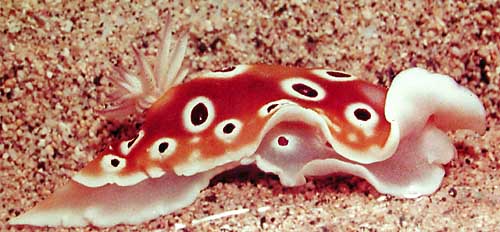This species has been observed on Reunion and Mauritius Islands
Species characteristics : They have large purplish red spots or marks, usually ringed with white, and often reticulate brownish background. The rhinophore clubs are purple It has a narrow purple border on the mantle and the foot. Only a narrow purple border on the foot in our specimens |

|
|
| Showing species characteristics... | Photo Philibert Bidgrain Reunion, Etang salé les bains, 16 October 2005, size 50 mm |
|
See more about : Sightening and mating periods
See more about : Chromodoris cf geminus variability in Southwest Indian ocean
Remarks :
Presumptive identification by Bill Rudman and Nathalie Yonow
According Bill Rudman : " Specimens of Goniobranchus cavae from Reunion Island show an incredible range of variation, including forms in which the diffuse yellow-orange spots become browner and expand to form one large brownish patch. In the most extreme form of this pattern, the purple spots become fewer and much larger and all the mantle, except for a narrow white band at the edge, becomes a uniform yellow-brown background. I had earlier separated specimens from South Africa with that colour pattern into a separate species which I called Chromodoris cf. geminus, but the photos we now have from Reunion Is, Mauritius and South Africa suggest that this is just an extreme colour variant of G. cavae.
I could of course be quite wrong, but for those who believe in parsimony, this seems to be a much more parsimonious hypothesis than 5 or 6 new species. "
In, Atlas mondial des nudibranches (Debelius, 2007) they are considered as two differents species...Goniobranchus cavae and Chromodoris cf geminus as Chromodoris sp1
In, Indo-pacific nudibranchs and seaslugs. A field guide to the World's most diverse fauna (Gosliner, 2008) we can found Chromodoris cf geminus as Chromodoris sp 12
If you have any idea about this hypothesis, contact us...
Bibliographic data :
Valda Fraser's shows that this species has the more usual waves of movement down each side of the mantle.Not the very distinctive behavioural characteristic of G. geminus, for which the mantle edge is raised and lowered in one movement all around the mantle edge.
Usually, it has a narrow purple border on the mantle and the foot, but specimens from Mauritius and Reunion Island haven't this marginal mantle purple border...
This is one of a group of similarly coloured species which includes Risbecia tryoni, Goniobranchus leopardus, Goniobranchus cavae and Chromodoris cf geminus.
But there are some differences
Risbecia tryoni
C. cf geminus
G. leopardus
Distribution
Indo Pacific
West Indian Ocean
Tropical West Pacific
Gills
The gills are cream with brown edges
White with purple tips
The gills are translucent cream
Rhinophores
The rhinophore clubs are brown.
White with purple tips
The rhinophore clubs are partially purple/bluish
Mantle overlap
High shape of the body, with a reduced mantle overlap.
Flat body shape with a wide mantle overlap.
Dorsum border
A narrow purple border with brownish patches around the edge
An irregular washy purple border
A fine purple border (absent from our specimens) with a white region inside
A narrow purple border
Dorsum central area
Large dirty brown central patch with uniform brown-purple round spots usually ringed with white.
Large very variable in color orange-brown central patch with dark purple spots ringed with white and with sometimes orange spots
Large brownish central patch with large purplish red spots or marks, usually ringed with white.
Multiple spots or marks, forming hollow squares, like the leopard fur
References :
Bill Rudman Sea slug site : Sea Slug Forum : Chromodoris cf. geminus
Other photos of Chromodoris cf. geminus :
Philibert Bidgrain Reunion, Pattern's modification of one specimen from 9 October to 8 November 2005. This specimen was found with two other on the same area during this period. Etang salé les bains, on a rocky coast |
 |
 |
 |
 |
Philibert Bidgrain Some morphologicals details.
|
 |
 |
 |
Philibert Bidgrain Reunion, Etang salé les bains, on a rocky coast, 16 October 2005, size : 20-25 mm. You can observe submarginal mantle glands by transparency found all around the mantle. the mantle This specimen looks like some colored form of Chromodoris cavae |
Maurice Jay Reunion, This species has the more usual waves of movement down each side of the mantle.Not the very distinctive behavioural characteristic of C. geminus, for which the mantle edge is raised and lowered in one movement all around the mantle edge. |
 |
More photos from Indian Ocean
See more about : Chromodoris cf geminus variability in Southwest Indian ocean
Mauritius, Chromodoris cf.geminus, at Pereybère , by Marina Poddubetskaia.
Reunion, Chromodoris cf.geminus, at Saint Gilles, by Maurice Jay
Reunion, Chromodoris cf.geminus with dark purple coloration, at Etang salé, by Hugues Flodrops
Reunion, Chromodoris cf geminus with retracted gills, at Etang salé, by Christophe Cadet
Reunion, Chromodoris cf geminus, at Etang salé, by Christophe Cadet
Reunion, when C. conchyliata meet C. cf geminus, at Etang salé, by Hugues Flodrops
Mauritius, Chromodoris cf geminus with few large purplish red spots, at Mahebourg, by David Faget
Reunion, juvenile of Chromodoris cf geminus, at Etang salé, by Philibert Bidgrain
Mauritius, Chromodoris cf geminus with few large purplish red spots, by Nathalie Rodrigues
